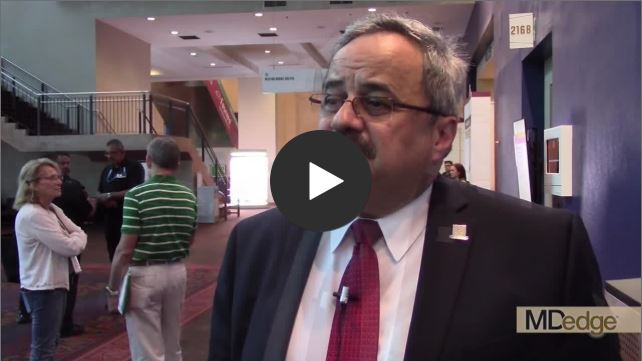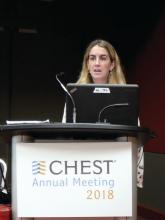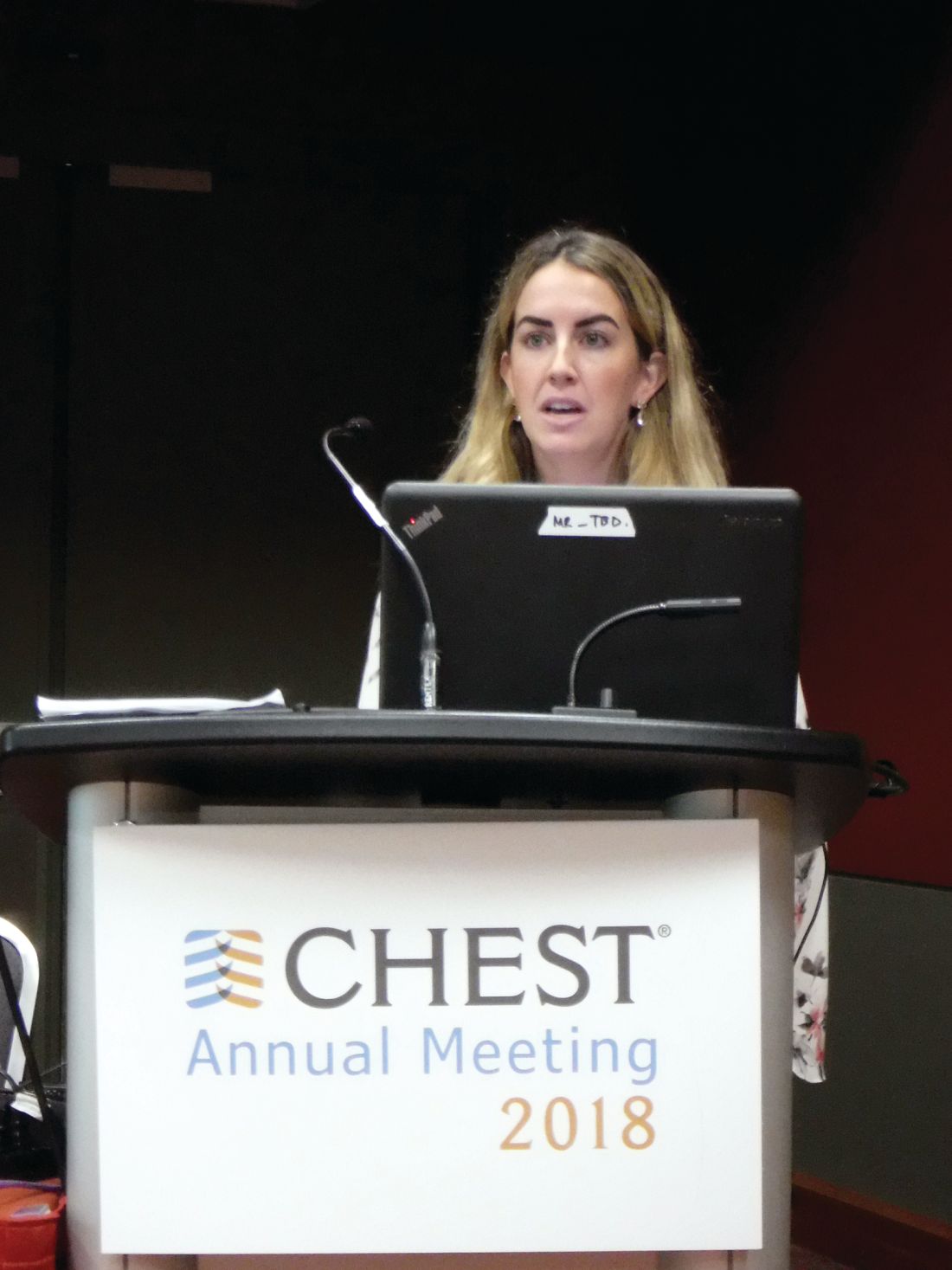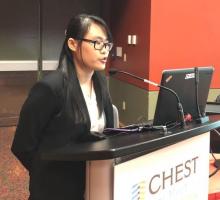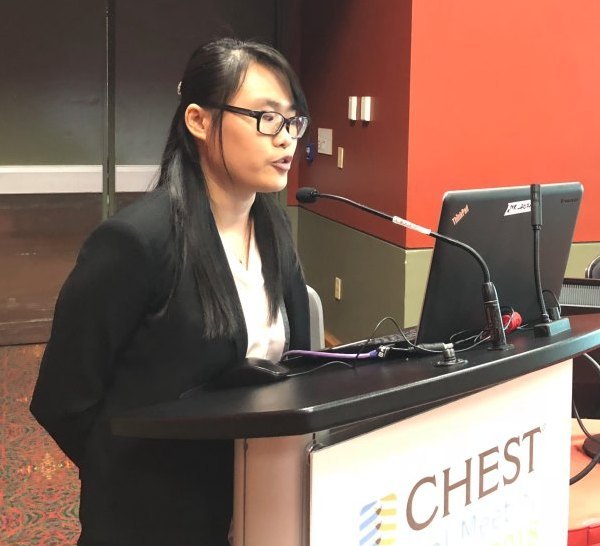User login
Obesity paradox extends to PE patients
SAN ANTONIO – compared with those who are not obese, according to results of a retrospective analysis covering 13 years and nearly 2 million PE discharges.
The obese patients in the analysis had a lower mortality risk, despite receiving more thrombolytics and mechanical intubation, said investigator Zubair Khan, MD, an internal medicine resident at the University of Toledo (Ohio) Medical Center.
“Surprisingly, the mortality of PE was significantly less in obese patients,” Dr. Khan said in a podium presentation at the annual meeting of the American College of Chest Physicians. “When we initiated the study, we did not expect this result.”
The association between obesity and lower mortality, sometimes called the “obesity paradox,” has been observed in studies of other chronic health conditions including stable heart failure, coronary artery disease, unstable angina, MI, and also in some PE studies, Dr. Khan said.
The study by Dr. Khan and his colleagues, based on the National Inpatient Sample (NIS) database, included adults with a primary discharge diagnosis of PE between 2002 and 2014. They included 1,959,018 PE discharges, of which 312,770 (16%) had an underlying obesity diagnosis.
Obese PE patients had more risk factors and more severe disease but had an overall mortality of 2.2%, compared with 3.7% in PE patients without obesity (P less than .001), Dr. Khan reported.
Hypertension was significantly more prevalent in the obese PE patients (65% vs. 50.5%; P less than .001), as was chronic lung disease and chronic liver disease, he noted in his presentation.
Obese patients more often received thrombolytics (3.6% vs. 1.9%; P less than .001) and mechanical ventilation (5.8% vs. 4%; P less than .001), and more frequently had cardiogenic shock (0.65% vs. 0.45%; P less than .001), he said.
The obese PE patients were more often female, black, and younger than 65 years of age, it was reported.
Notably, the prevalence of obesity in PE patients more than doubled over the course of the study period, from 10.2% in 2002 to 22.6% in 2014, Dr. Khan added.
The paradoxically lower mortality in obese patients might be explained by increased levels of endocannabinoids, which have shown protective effects in rat and mouse studies, Dr. Khan told attendees at the meeting.
“I think it’s a rich area for more and further research, especially in basic science,” Dr. Khan said.
Dr. Khan and his coauthors disclosed that they had no relationships relevant to the study.
SOURCE: Khan Z et al. CHEST. 2018 Oct. doi: 10.1016/j.chest.2018.08.919.
SAN ANTONIO – compared with those who are not obese, according to results of a retrospective analysis covering 13 years and nearly 2 million PE discharges.
The obese patients in the analysis had a lower mortality risk, despite receiving more thrombolytics and mechanical intubation, said investigator Zubair Khan, MD, an internal medicine resident at the University of Toledo (Ohio) Medical Center.
“Surprisingly, the mortality of PE was significantly less in obese patients,” Dr. Khan said in a podium presentation at the annual meeting of the American College of Chest Physicians. “When we initiated the study, we did not expect this result.”
The association between obesity and lower mortality, sometimes called the “obesity paradox,” has been observed in studies of other chronic health conditions including stable heart failure, coronary artery disease, unstable angina, MI, and also in some PE studies, Dr. Khan said.
The study by Dr. Khan and his colleagues, based on the National Inpatient Sample (NIS) database, included adults with a primary discharge diagnosis of PE between 2002 and 2014. They included 1,959,018 PE discharges, of which 312,770 (16%) had an underlying obesity diagnosis.
Obese PE patients had more risk factors and more severe disease but had an overall mortality of 2.2%, compared with 3.7% in PE patients without obesity (P less than .001), Dr. Khan reported.
Hypertension was significantly more prevalent in the obese PE patients (65% vs. 50.5%; P less than .001), as was chronic lung disease and chronic liver disease, he noted in his presentation.
Obese patients more often received thrombolytics (3.6% vs. 1.9%; P less than .001) and mechanical ventilation (5.8% vs. 4%; P less than .001), and more frequently had cardiogenic shock (0.65% vs. 0.45%; P less than .001), he said.
The obese PE patients were more often female, black, and younger than 65 years of age, it was reported.
Notably, the prevalence of obesity in PE patients more than doubled over the course of the study period, from 10.2% in 2002 to 22.6% in 2014, Dr. Khan added.
The paradoxically lower mortality in obese patients might be explained by increased levels of endocannabinoids, which have shown protective effects in rat and mouse studies, Dr. Khan told attendees at the meeting.
“I think it’s a rich area for more and further research, especially in basic science,” Dr. Khan said.
Dr. Khan and his coauthors disclosed that they had no relationships relevant to the study.
SOURCE: Khan Z et al. CHEST. 2018 Oct. doi: 10.1016/j.chest.2018.08.919.
SAN ANTONIO – compared with those who are not obese, according to results of a retrospective analysis covering 13 years and nearly 2 million PE discharges.
The obese patients in the analysis had a lower mortality risk, despite receiving more thrombolytics and mechanical intubation, said investigator Zubair Khan, MD, an internal medicine resident at the University of Toledo (Ohio) Medical Center.
“Surprisingly, the mortality of PE was significantly less in obese patients,” Dr. Khan said in a podium presentation at the annual meeting of the American College of Chest Physicians. “When we initiated the study, we did not expect this result.”
The association between obesity and lower mortality, sometimes called the “obesity paradox,” has been observed in studies of other chronic health conditions including stable heart failure, coronary artery disease, unstable angina, MI, and also in some PE studies, Dr. Khan said.
The study by Dr. Khan and his colleagues, based on the National Inpatient Sample (NIS) database, included adults with a primary discharge diagnosis of PE between 2002 and 2014. They included 1,959,018 PE discharges, of which 312,770 (16%) had an underlying obesity diagnosis.
Obese PE patients had more risk factors and more severe disease but had an overall mortality of 2.2%, compared with 3.7% in PE patients without obesity (P less than .001), Dr. Khan reported.
Hypertension was significantly more prevalent in the obese PE patients (65% vs. 50.5%; P less than .001), as was chronic lung disease and chronic liver disease, he noted in his presentation.
Obese patients more often received thrombolytics (3.6% vs. 1.9%; P less than .001) and mechanical ventilation (5.8% vs. 4%; P less than .001), and more frequently had cardiogenic shock (0.65% vs. 0.45%; P less than .001), he said.
The obese PE patients were more often female, black, and younger than 65 years of age, it was reported.
Notably, the prevalence of obesity in PE patients more than doubled over the course of the study period, from 10.2% in 2002 to 22.6% in 2014, Dr. Khan added.
The paradoxically lower mortality in obese patients might be explained by increased levels of endocannabinoids, which have shown protective effects in rat and mouse studies, Dr. Khan told attendees at the meeting.
“I think it’s a rich area for more and further research, especially in basic science,” Dr. Khan said.
Dr. Khan and his coauthors disclosed that they had no relationships relevant to the study.
SOURCE: Khan Z et al. CHEST. 2018 Oct. doi: 10.1016/j.chest.2018.08.919.
REPORTING FROM CHEST 2018
Key clinical point: The obesity paradox observed in other chronic conditions held true in this study of patients with pulmonary embolism (PE).
Major finding: Obese PE patients had more risk factors and more severe disease, but an overall mortality of 2.2% vs 3.7% in nonobese PE patients.
Study details: Retrospective analysis of the National Inpatient Sample (NIS) database including almost 2 million individuals with a primary discharge diagnosis of PE.
Disclosures: Study authors had no disclosures.
Source: Khan Z et al. CHEST. 2018 Oct. doi: 10.1016/j.chest.2018.08.919.
Planning for ventilator-dependent patients during natural disasters

SAN ANTONIO – For patients with neuromuscular disorders, the stress and danger from natural disasters such Hurricane Harvey are best avoided by leaving the area as soon as possible, according to Venessa A. Holland, MD, FCCP, of Houston Methodist Hospital.
While none of Dr. Holland’s patients died during this catastrophic hurricane, there were considerable challenges, particularly for those trapped by the many trillion gallons of water fell on Texas and Louisiana in August 2017. Houston was flooded, and hospitals and other medical facilities were hit hard. The vulnerability of ventilator-dependent and incapacitated patients was of particular concern.
In one case, a ventilator-dependent patient trapped by flood waters at home became diaphoretic and hypotensive. The patient was treated with electrolyte-replacement sports drink administered via percutaneous endoscopic gastrostomy (PEG) tube, Dr. Holland told attendees at the annual meeting of the American College of Chest Physicians.
Dr. Holland spoke in a video interview about how neuromuscular disorder patients fared during Hurricane Harvey and her recommendations for the next natural disaster.
Dr. Holland disclosed that she previously served as a consultant to Hill-Rom.

SAN ANTONIO – For patients with neuromuscular disorders, the stress and danger from natural disasters such Hurricane Harvey are best avoided by leaving the area as soon as possible, according to Venessa A. Holland, MD, FCCP, of Houston Methodist Hospital.
While none of Dr. Holland’s patients died during this catastrophic hurricane, there were considerable challenges, particularly for those trapped by the many trillion gallons of water fell on Texas and Louisiana in August 2017. Houston was flooded, and hospitals and other medical facilities were hit hard. The vulnerability of ventilator-dependent and incapacitated patients was of particular concern.
In one case, a ventilator-dependent patient trapped by flood waters at home became diaphoretic and hypotensive. The patient was treated with electrolyte-replacement sports drink administered via percutaneous endoscopic gastrostomy (PEG) tube, Dr. Holland told attendees at the annual meeting of the American College of Chest Physicians.
Dr. Holland spoke in a video interview about how neuromuscular disorder patients fared during Hurricane Harvey and her recommendations for the next natural disaster.
Dr. Holland disclosed that she previously served as a consultant to Hill-Rom.

SAN ANTONIO – For patients with neuromuscular disorders, the stress and danger from natural disasters such Hurricane Harvey are best avoided by leaving the area as soon as possible, according to Venessa A. Holland, MD, FCCP, of Houston Methodist Hospital.
While none of Dr. Holland’s patients died during this catastrophic hurricane, there were considerable challenges, particularly for those trapped by the many trillion gallons of water fell on Texas and Louisiana in August 2017. Houston was flooded, and hospitals and other medical facilities were hit hard. The vulnerability of ventilator-dependent and incapacitated patients was of particular concern.
In one case, a ventilator-dependent patient trapped by flood waters at home became diaphoretic and hypotensive. The patient was treated with electrolyte-replacement sports drink administered via percutaneous endoscopic gastrostomy (PEG) tube, Dr. Holland told attendees at the annual meeting of the American College of Chest Physicians.
Dr. Holland spoke in a video interview about how neuromuscular disorder patients fared during Hurricane Harvey and her recommendations for the next natural disaster.
Dr. Holland disclosed that she previously served as a consultant to Hill-Rom.
REPORTING FROM CHEST 2018
Latest clinical trials advance COPD management

SAN ANTONIO – Recent studies have shown that the use of a long-acting beta2-agonist/long-acting muscarinic antagonist (LABA/LAMA) combination is superior to LAMA alone in endpoints including exacerbation, Nicola A. Hanania, MD, FCCP, said in a panel discussion session at the annual meeting of the American College of Chest Physicians.
Other recent evidence has shown that the use of LABA/LAMA has cardiovascular benefits in hyperinflated patients with COPD, according to Dr. Hanania, director of the Airways Clinical Research Center at Baylor College of Medicine, Houston.
Meanwhile, emerging data in patients with advanced COPD have demonstrated the benefits of single-inhaler triple therapy with inhaled corticosteroid (ICS)/LABA/LAMA versus LABA/LAMA or ICS/LABA combinations, Dr. Hanania said in an interview.
The past year also has brought news that ICS de-escalation is possible in patients with moderate COPD with no exacerbation risk, though it may not be possible in patients with high baseline blood eosinophils, he added.
Recent developments have not all been about drug therapy. The Zephyr endobronchial valve improved outcomes in patients with little to no collateral ventilation in target lobes, Dr. Hanania said. However, the therapy comes with a potential risk of pneumothorax, so patients need to be monitored in the hospital.
Dr. Hanania provided disclosures related to Roche (Genentech), AstraZeneca, Boehringer Ingelheim, Novartis, GlaxoSmithKline, and Sanofi/Regeneron, as well as institutional research grant support from the National Heart, Lung, and Blood Institute and the American Lung Association.

SAN ANTONIO – Recent studies have shown that the use of a long-acting beta2-agonist/long-acting muscarinic antagonist (LABA/LAMA) combination is superior to LAMA alone in endpoints including exacerbation, Nicola A. Hanania, MD, FCCP, said in a panel discussion session at the annual meeting of the American College of Chest Physicians.
Other recent evidence has shown that the use of LABA/LAMA has cardiovascular benefits in hyperinflated patients with COPD, according to Dr. Hanania, director of the Airways Clinical Research Center at Baylor College of Medicine, Houston.
Meanwhile, emerging data in patients with advanced COPD have demonstrated the benefits of single-inhaler triple therapy with inhaled corticosteroid (ICS)/LABA/LAMA versus LABA/LAMA or ICS/LABA combinations, Dr. Hanania said in an interview.
The past year also has brought news that ICS de-escalation is possible in patients with moderate COPD with no exacerbation risk, though it may not be possible in patients with high baseline blood eosinophils, he added.
Recent developments have not all been about drug therapy. The Zephyr endobronchial valve improved outcomes in patients with little to no collateral ventilation in target lobes, Dr. Hanania said. However, the therapy comes with a potential risk of pneumothorax, so patients need to be monitored in the hospital.
Dr. Hanania provided disclosures related to Roche (Genentech), AstraZeneca, Boehringer Ingelheim, Novartis, GlaxoSmithKline, and Sanofi/Regeneron, as well as institutional research grant support from the National Heart, Lung, and Blood Institute and the American Lung Association.

SAN ANTONIO – Recent studies have shown that the use of a long-acting beta2-agonist/long-acting muscarinic antagonist (LABA/LAMA) combination is superior to LAMA alone in endpoints including exacerbation, Nicola A. Hanania, MD, FCCP, said in a panel discussion session at the annual meeting of the American College of Chest Physicians.
Other recent evidence has shown that the use of LABA/LAMA has cardiovascular benefits in hyperinflated patients with COPD, according to Dr. Hanania, director of the Airways Clinical Research Center at Baylor College of Medicine, Houston.
Meanwhile, emerging data in patients with advanced COPD have demonstrated the benefits of single-inhaler triple therapy with inhaled corticosteroid (ICS)/LABA/LAMA versus LABA/LAMA or ICS/LABA combinations, Dr. Hanania said in an interview.
The past year also has brought news that ICS de-escalation is possible in patients with moderate COPD with no exacerbation risk, though it may not be possible in patients with high baseline blood eosinophils, he added.
Recent developments have not all been about drug therapy. The Zephyr endobronchial valve improved outcomes in patients with little to no collateral ventilation in target lobes, Dr. Hanania said. However, the therapy comes with a potential risk of pneumothorax, so patients need to be monitored in the hospital.
Dr. Hanania provided disclosures related to Roche (Genentech), AstraZeneca, Boehringer Ingelheim, Novartis, GlaxoSmithKline, and Sanofi/Regeneron, as well as institutional research grant support from the National Heart, Lung, and Blood Institute and the American Lung Association.
REPORTING FROM CHEST 2018
Precision medicine poised to improve IPF management
SAN ANTONIO – Although the research is in early phases, (IPF), Justin Oldham, MD, said in a plenary presentation at the annual meeting of the American College of Chest Physicians.

“IPF is a highly variable disease,” said Dr. Oldham, director of the Interstitial Lung Disease Program at the University of California, Davis. “Some patients have more rapidly progressive disease than others, and so using precision medicine to identify those who are most likely to have that progressive phenotype is very important, not only for risk stratification but also treatment considerations.”
Some retrospective studies suggest certain subgroups of patients with IPF are genetically predisposed to respond to certain types of therapy, he said in a video interview. Now, researchers are in the process of submitting grants to better study that in a prospective fashion.
Dr. Oldham reported receiving funding from the National Institutes of Health, the American Lung Association, and the ACCP, as well as consulting and speaker fees from Genentech and Boehringer Ingelheim.
SAN ANTONIO – Although the research is in early phases, (IPF), Justin Oldham, MD, said in a plenary presentation at the annual meeting of the American College of Chest Physicians.

“IPF is a highly variable disease,” said Dr. Oldham, director of the Interstitial Lung Disease Program at the University of California, Davis. “Some patients have more rapidly progressive disease than others, and so using precision medicine to identify those who are most likely to have that progressive phenotype is very important, not only for risk stratification but also treatment considerations.”
Some retrospective studies suggest certain subgroups of patients with IPF are genetically predisposed to respond to certain types of therapy, he said in a video interview. Now, researchers are in the process of submitting grants to better study that in a prospective fashion.
Dr. Oldham reported receiving funding from the National Institutes of Health, the American Lung Association, and the ACCP, as well as consulting and speaker fees from Genentech and Boehringer Ingelheim.
SAN ANTONIO – Although the research is in early phases, (IPF), Justin Oldham, MD, said in a plenary presentation at the annual meeting of the American College of Chest Physicians.

“IPF is a highly variable disease,” said Dr. Oldham, director of the Interstitial Lung Disease Program at the University of California, Davis. “Some patients have more rapidly progressive disease than others, and so using precision medicine to identify those who are most likely to have that progressive phenotype is very important, not only for risk stratification but also treatment considerations.”
Some retrospective studies suggest certain subgroups of patients with IPF are genetically predisposed to respond to certain types of therapy, he said in a video interview. Now, researchers are in the process of submitting grants to better study that in a prospective fashion.
Dr. Oldham reported receiving funding from the National Institutes of Health, the American Lung Association, and the ACCP, as well as consulting and speaker fees from Genentech and Boehringer Ingelheim.
EXPERT ANALYSIS FROM CHEST 2018
Pulmonary NP ensures care continuity, reduces readmissions
SAN ANTONIO – Unplanned whose discharge process involved a pulmonary nurse practitioner to coordinate continuity of care, a study of more than 70 patients has found.
Despite an increase over time in the rate of discharges, readmissions fell, Sarah Barry, CRNP, of Children’s Hospital of Philadelphia (CHOP), said at the annual meeting of the American College of Chest Physicians.
“The technology-dependent pediatric population who is going home with tracheostomy and ventilator dependence is at risk for hospital readmission, and having an advanced practice provider in a continuity role promotes adherence to our standards of practice and improves transition to home,” Ms. Barry said in an interview.
She noted previous research showing that 40% of 109 home mechanical ventilation patients discharged between 2003 and 2009 had unplanned readmissions, 28% of which occurred within the first month after discharge.
Nearly two thirds (64%) of those readmissions were related to a pulmonary and/or tracheostomy problem. That study also found that changes in condition management 1 week before discharge, such as medications, ventilator settings, or feeding regimens, was associated with unplanned readmission.
That research “makes us ask ourselves if our readmissions are avoidable and what can we do to get these kids home safe and to keep them home,” Ms. Barry told attendees, adding that CHOP was unhappy with their readmission rates.
“Kids were often not making it to their first pulmonary appointment, and it was a burden for these families,” she said. “We questioned whether or not having a nurse practitioner in a role to promote adherence to our standards would have a positive impact on our unplanned route.”
They evaluated the effect of such an NP on unplanned readmissions among tracheostomy/ventilator-supported children. The NP’s role was to track patients, mostly from the progressive care unit, who required a tracheostomy and ventilator and were expected to be discharged home or to a long-term care facility. The NP provided continuity for medical management and coordinated care at discharge.
“We also do not make changes for 2 weeks before discharge so that we can focus on all the other coordination that goes into getting these kids home,” Ms. Barry said.
She reviewed the patients’ electronic charts to record time to scheduled follow-up visit, days until hospital readmission, admitting diagnosis at readmission, and length of stay after readmission. With consideration for the time needed for transition into this new process, the population studied was assessed within three cohorts.
The first cohort comprised the 22 children discharged between April 2016 and March 2017, the full year before a pulmonary NP began coordinating the discharge process. These patients averaged 1.8 discharges per month with an initial follow-up of 2-12 weeks.
Just over a quarter (27%) of the first cohort were readmitted before their scheduled follow-up, ranging from 2 to 25 days after discharge. Five percent were readmitted within a week of discharge, and 27% were readmitted within a month; their average length of stay was 13 days after readmission. Most (83%) of these discharges were respiratory related while the other 17% were gastrointestinal related.
The second cohort involved the 11 patients discharged between April 2017 and August 2017, the first 5 months after a pulmonary NP began overseeing the discharge readiness process.
“We chose 5 months because it took about 5months for me to develop my own protocols and standards of practice,” Ms. Barry explained.
An average 2.2 discharges occurred monthly with 2-8 weeks of initial postdischarge follow-up. Though nearly half these children (45%) were readmitted before their scheduled follow-up, their length of stay was shorter, an average of 11 days.
Readmission within a week after discharge occurred among 27% of the children, and 45% of them were readmitted within a month of discharge. Sixty percent of these patients were readmitted for respiratory issues, compared with 40% with GI issues.
The third cohort included all 38 patients discharged from September 2017 to August 2018, the year after a pulmonary NP had become fully established in the continuity role, with an average 3.2 discharges occurred per month. Readmission rates were considerably lower: Eighteen percent of patients were readmitted before their scheduled follow-up appointment, which ranged from 1 to 13 weeks after discharge.
Five percent were readmitted within a week of discharge, and 24% were readmitted within a month, ranging from 1 to 26 days post discharge. But length of stay was shorter still at an average of 9 days.
The reasons for readmission varied more in this cohort: While 56% were respiratory related, 22% were related to fever, and 11% were related to neurodevelopment concerns or social reasons, such as necessary involvement of social services.
Ms. Barry’s colleague, Howard B. Panitch, MD, also on the staff of CHOP, noted during the discussion that the NP’s role is invaluable in “keeping the inpatient teams honest.
“She reminds her colleagues in critical care that you can’t make that ventilator change when on your way out the door or very close to discharge.”
Ms. Barry had no disclosures. No external funding was noted.
SOURCE: Barry S et al. CHEST 2018 Oct. doi: 10.1016/j.chest.2018.08.743.
SAN ANTONIO – Unplanned whose discharge process involved a pulmonary nurse practitioner to coordinate continuity of care, a study of more than 70 patients has found.
Despite an increase over time in the rate of discharges, readmissions fell, Sarah Barry, CRNP, of Children’s Hospital of Philadelphia (CHOP), said at the annual meeting of the American College of Chest Physicians.
“The technology-dependent pediatric population who is going home with tracheostomy and ventilator dependence is at risk for hospital readmission, and having an advanced practice provider in a continuity role promotes adherence to our standards of practice and improves transition to home,” Ms. Barry said in an interview.
She noted previous research showing that 40% of 109 home mechanical ventilation patients discharged between 2003 and 2009 had unplanned readmissions, 28% of which occurred within the first month after discharge.
Nearly two thirds (64%) of those readmissions were related to a pulmonary and/or tracheostomy problem. That study also found that changes in condition management 1 week before discharge, such as medications, ventilator settings, or feeding regimens, was associated with unplanned readmission.
That research “makes us ask ourselves if our readmissions are avoidable and what can we do to get these kids home safe and to keep them home,” Ms. Barry told attendees, adding that CHOP was unhappy with their readmission rates.
“Kids were often not making it to their first pulmonary appointment, and it was a burden for these families,” she said. “We questioned whether or not having a nurse practitioner in a role to promote adherence to our standards would have a positive impact on our unplanned route.”
They evaluated the effect of such an NP on unplanned readmissions among tracheostomy/ventilator-supported children. The NP’s role was to track patients, mostly from the progressive care unit, who required a tracheostomy and ventilator and were expected to be discharged home or to a long-term care facility. The NP provided continuity for medical management and coordinated care at discharge.
“We also do not make changes for 2 weeks before discharge so that we can focus on all the other coordination that goes into getting these kids home,” Ms. Barry said.
She reviewed the patients’ electronic charts to record time to scheduled follow-up visit, days until hospital readmission, admitting diagnosis at readmission, and length of stay after readmission. With consideration for the time needed for transition into this new process, the population studied was assessed within three cohorts.
The first cohort comprised the 22 children discharged between April 2016 and March 2017, the full year before a pulmonary NP began coordinating the discharge process. These patients averaged 1.8 discharges per month with an initial follow-up of 2-12 weeks.
Just over a quarter (27%) of the first cohort were readmitted before their scheduled follow-up, ranging from 2 to 25 days after discharge. Five percent were readmitted within a week of discharge, and 27% were readmitted within a month; their average length of stay was 13 days after readmission. Most (83%) of these discharges were respiratory related while the other 17% were gastrointestinal related.
The second cohort involved the 11 patients discharged between April 2017 and August 2017, the first 5 months after a pulmonary NP began overseeing the discharge readiness process.
“We chose 5 months because it took about 5months for me to develop my own protocols and standards of practice,” Ms. Barry explained.
An average 2.2 discharges occurred monthly with 2-8 weeks of initial postdischarge follow-up. Though nearly half these children (45%) were readmitted before their scheduled follow-up, their length of stay was shorter, an average of 11 days.
Readmission within a week after discharge occurred among 27% of the children, and 45% of them were readmitted within a month of discharge. Sixty percent of these patients were readmitted for respiratory issues, compared with 40% with GI issues.
The third cohort included all 38 patients discharged from September 2017 to August 2018, the year after a pulmonary NP had become fully established in the continuity role, with an average 3.2 discharges occurred per month. Readmission rates were considerably lower: Eighteen percent of patients were readmitted before their scheduled follow-up appointment, which ranged from 1 to 13 weeks after discharge.
Five percent were readmitted within a week of discharge, and 24% were readmitted within a month, ranging from 1 to 26 days post discharge. But length of stay was shorter still at an average of 9 days.
The reasons for readmission varied more in this cohort: While 56% were respiratory related, 22% were related to fever, and 11% were related to neurodevelopment concerns or social reasons, such as necessary involvement of social services.
Ms. Barry’s colleague, Howard B. Panitch, MD, also on the staff of CHOP, noted during the discussion that the NP’s role is invaluable in “keeping the inpatient teams honest.
“She reminds her colleagues in critical care that you can’t make that ventilator change when on your way out the door or very close to discharge.”
Ms. Barry had no disclosures. No external funding was noted.
SOURCE: Barry S et al. CHEST 2018 Oct. doi: 10.1016/j.chest.2018.08.743.
SAN ANTONIO – Unplanned whose discharge process involved a pulmonary nurse practitioner to coordinate continuity of care, a study of more than 70 patients has found.
Despite an increase over time in the rate of discharges, readmissions fell, Sarah Barry, CRNP, of Children’s Hospital of Philadelphia (CHOP), said at the annual meeting of the American College of Chest Physicians.
“The technology-dependent pediatric population who is going home with tracheostomy and ventilator dependence is at risk for hospital readmission, and having an advanced practice provider in a continuity role promotes adherence to our standards of practice and improves transition to home,” Ms. Barry said in an interview.
She noted previous research showing that 40% of 109 home mechanical ventilation patients discharged between 2003 and 2009 had unplanned readmissions, 28% of which occurred within the first month after discharge.
Nearly two thirds (64%) of those readmissions were related to a pulmonary and/or tracheostomy problem. That study also found that changes in condition management 1 week before discharge, such as medications, ventilator settings, or feeding regimens, was associated with unplanned readmission.
That research “makes us ask ourselves if our readmissions are avoidable and what can we do to get these kids home safe and to keep them home,” Ms. Barry told attendees, adding that CHOP was unhappy with their readmission rates.
“Kids were often not making it to their first pulmonary appointment, and it was a burden for these families,” she said. “We questioned whether or not having a nurse practitioner in a role to promote adherence to our standards would have a positive impact on our unplanned route.”
They evaluated the effect of such an NP on unplanned readmissions among tracheostomy/ventilator-supported children. The NP’s role was to track patients, mostly from the progressive care unit, who required a tracheostomy and ventilator and were expected to be discharged home or to a long-term care facility. The NP provided continuity for medical management and coordinated care at discharge.
“We also do not make changes for 2 weeks before discharge so that we can focus on all the other coordination that goes into getting these kids home,” Ms. Barry said.
She reviewed the patients’ electronic charts to record time to scheduled follow-up visit, days until hospital readmission, admitting diagnosis at readmission, and length of stay after readmission. With consideration for the time needed for transition into this new process, the population studied was assessed within three cohorts.
The first cohort comprised the 22 children discharged between April 2016 and March 2017, the full year before a pulmonary NP began coordinating the discharge process. These patients averaged 1.8 discharges per month with an initial follow-up of 2-12 weeks.
Just over a quarter (27%) of the first cohort were readmitted before their scheduled follow-up, ranging from 2 to 25 days after discharge. Five percent were readmitted within a week of discharge, and 27% were readmitted within a month; their average length of stay was 13 days after readmission. Most (83%) of these discharges were respiratory related while the other 17% were gastrointestinal related.
The second cohort involved the 11 patients discharged between April 2017 and August 2017, the first 5 months after a pulmonary NP began overseeing the discharge readiness process.
“We chose 5 months because it took about 5months for me to develop my own protocols and standards of practice,” Ms. Barry explained.
An average 2.2 discharges occurred monthly with 2-8 weeks of initial postdischarge follow-up. Though nearly half these children (45%) were readmitted before their scheduled follow-up, their length of stay was shorter, an average of 11 days.
Readmission within a week after discharge occurred among 27% of the children, and 45% of them were readmitted within a month of discharge. Sixty percent of these patients were readmitted for respiratory issues, compared with 40% with GI issues.
The third cohort included all 38 patients discharged from September 2017 to August 2018, the year after a pulmonary NP had become fully established in the continuity role, with an average 3.2 discharges occurred per month. Readmission rates were considerably lower: Eighteen percent of patients were readmitted before their scheduled follow-up appointment, which ranged from 1 to 13 weeks after discharge.
Five percent were readmitted within a week of discharge, and 24% were readmitted within a month, ranging from 1 to 26 days post discharge. But length of stay was shorter still at an average of 9 days.
The reasons for readmission varied more in this cohort: While 56% were respiratory related, 22% were related to fever, and 11% were related to neurodevelopment concerns or social reasons, such as necessary involvement of social services.
Ms. Barry’s colleague, Howard B. Panitch, MD, also on the staff of CHOP, noted during the discussion that the NP’s role is invaluable in “keeping the inpatient teams honest.
“She reminds her colleagues in critical care that you can’t make that ventilator change when on your way out the door or very close to discharge.”
Ms. Barry had no disclosures. No external funding was noted.
SOURCE: Barry S et al. CHEST 2018 Oct. doi: 10.1016/j.chest.2018.08.743.
REPORTING FROM CHEST 2018
Key clinical point: Use of pulmonary NP for continuity care decreases unplanned readmissions among pediatric tracheostomy/ventilator patients.
Major finding: Unplanned readmission rates declined from 27% to 18% before the patient’s first follow-up appointment.
Study details: A retrospective electronic chart review of 71 tracheostomy/ventilator-dependent children discharged between April 2016 and August 2018 at Children’s Hospital of Philadelphia.
Disclosures: Ms. Barry had no disclosures. No external funding was noted.
Source: Barry S et al. CHEST 2018 Oct. doi: 10.1016/j.chest.2018.08.743.
ADVENT-HF early results: High ASV compliance, no safety concerns
SAN ANTONIO – The in heart failure patients with sleep apnea, so far has better compliance than previous trials, with no safety concerns to date, according to investigator T. Douglas Bradley, MD.
On average, patients with obstructive sleep apnea were using the device 4.6 hours per night at 1 month and 4.1 hours at 12 months, while patients with central sleep apnea were using the device 5.2 hours per night both at 1 month and 12 months, Dr. Bradley said.
“This represents much better compliance than the other trials that have looked into this area, so we are quite happy about that,” Dr. Bradley said at the annual meeting of the American College of Chest Physicians.
The study has been reviewed five times by the data safety monitoring board since the announcement of SERVE-HF trial results, with no safety concerns in either obstructive sleep apnea or central sleep apnea patients, Dr. Bradley noted in a podium presentation.
The compliance results have been submitted for publication, though efficacy results of the study will have to wait. The estimated study completion date is June 2020, according to the latest study information on ClinicalTrials.gov.
More than 600 patients have been enrolled in ADVENT-HF to date, and the investigators hope to enroll more than 800: “We should be there by the end of next year,” Dr. Bradley said.
He provided disclosures related to Philips Respironics (funding and devices) and the Canadian Institutes of Health Research.
SAN ANTONIO – The in heart failure patients with sleep apnea, so far has better compliance than previous trials, with no safety concerns to date, according to investigator T. Douglas Bradley, MD.
On average, patients with obstructive sleep apnea were using the device 4.6 hours per night at 1 month and 4.1 hours at 12 months, while patients with central sleep apnea were using the device 5.2 hours per night both at 1 month and 12 months, Dr. Bradley said.
“This represents much better compliance than the other trials that have looked into this area, so we are quite happy about that,” Dr. Bradley said at the annual meeting of the American College of Chest Physicians.
The study has been reviewed five times by the data safety monitoring board since the announcement of SERVE-HF trial results, with no safety concerns in either obstructive sleep apnea or central sleep apnea patients, Dr. Bradley noted in a podium presentation.
The compliance results have been submitted for publication, though efficacy results of the study will have to wait. The estimated study completion date is June 2020, according to the latest study information on ClinicalTrials.gov.
More than 600 patients have been enrolled in ADVENT-HF to date, and the investigators hope to enroll more than 800: “We should be there by the end of next year,” Dr. Bradley said.
He provided disclosures related to Philips Respironics (funding and devices) and the Canadian Institutes of Health Research.
SAN ANTONIO – The in heart failure patients with sleep apnea, so far has better compliance than previous trials, with no safety concerns to date, according to investigator T. Douglas Bradley, MD.
On average, patients with obstructive sleep apnea were using the device 4.6 hours per night at 1 month and 4.1 hours at 12 months, while patients with central sleep apnea were using the device 5.2 hours per night both at 1 month and 12 months, Dr. Bradley said.
“This represents much better compliance than the other trials that have looked into this area, so we are quite happy about that,” Dr. Bradley said at the annual meeting of the American College of Chest Physicians.
The study has been reviewed five times by the data safety monitoring board since the announcement of SERVE-HF trial results, with no safety concerns in either obstructive sleep apnea or central sleep apnea patients, Dr. Bradley noted in a podium presentation.
The compliance results have been submitted for publication, though efficacy results of the study will have to wait. The estimated study completion date is June 2020, according to the latest study information on ClinicalTrials.gov.
More than 600 patients have been enrolled in ADVENT-HF to date, and the investigators hope to enroll more than 800: “We should be there by the end of next year,” Dr. Bradley said.
He provided disclosures related to Philips Respironics (funding and devices) and the Canadian Institutes of Health Research.
REPORTING FROM CHEST 2018
Dogs steal the show at CHEST 2018
SAN ANTONIO – Therapy Animals of San Antonio, a non-profit organization that trains and places therapy pets, delighted the attendees of CHEST 2018 with a number of therapy dogs. Christopher L. Carroll, MD, FCCP, and Kathy Jewett, CHEST Director, Membership and Brand Development, spoke about the many benefits pets can bring to patients, including stress reduction and emotional comfort. The therapy dogs also will be visiting the CHEST 2018 meeting on Tuesday and Wednesday, 11:30 a.m. to 1:30 p.m., in the Exhibit Hall.
SAN ANTONIO – Therapy Animals of San Antonio, a non-profit organization that trains and places therapy pets, delighted the attendees of CHEST 2018 with a number of therapy dogs. Christopher L. Carroll, MD, FCCP, and Kathy Jewett, CHEST Director, Membership and Brand Development, spoke about the many benefits pets can bring to patients, including stress reduction and emotional comfort. The therapy dogs also will be visiting the CHEST 2018 meeting on Tuesday and Wednesday, 11:30 a.m. to 1:30 p.m., in the Exhibit Hall.
SAN ANTONIO – Therapy Animals of San Antonio, a non-profit organization that trains and places therapy pets, delighted the attendees of CHEST 2018 with a number of therapy dogs. Christopher L. Carroll, MD, FCCP, and Kathy Jewett, CHEST Director, Membership and Brand Development, spoke about the many benefits pets can bring to patients, including stress reduction and emotional comfort. The therapy dogs also will be visiting the CHEST 2018 meeting on Tuesday and Wednesday, 11:30 a.m. to 1:30 p.m., in the Exhibit Hall.
REPORTING FROM CHEST 2018
Discharge trends for septic shock survivors remain steady
SAN ANTONIO – While septic shock mortality has decreased since the Surviving Sepsis Campaign guidelines were introduced, discharge trends for survivors have not changed significantly over time, a recent analysis suggests.
The percentage of survivors discharged to subacute rehab or long-term facilities did not change appreciably over time, according to the 10-year retrospective analysis, presented at the annual meeting of the American College of Chest Physicians.
However, average length of stay did significantly trend downward over the decade analyzed, while total charge per septic shock admission significantly increased, according to investigator Di Pan, DO, Icahn School of Medicine at Mount Sinai, New York, and his colleagues.
This is one of few studies looking at outcomes in survivors of septic shock, as most analyses have primarily focused on mortality outcomes, the investigators said.
Their analysis was based on the 2004 to 2014 National (Nationwide) Inpatient Sample databases and included patients with a primary diagnosis of septic shock at discharge.
Out of nearly 1.8 million patients with septic shock in that cohort, about 1 million survived, according to data Dr. Pan and colleagues provided in an abstract of the presentation.
In-hospital mortality decreased from 51.7% in 2004 to 39.3% in 2014 (P less than .001), the investigators reported.
The proportion of survivors discharged to subacute rehab or long-term acute care facilities was 61.9% in 2004, and similarly, 62.4% in 2014 (P = .1), while the percentage discharged home was 17.1% in 2004 and 15.1% in 2014 (P = 0.55).
However, there was a small but statistically significant downtick in mean length of stay, from 12.6 days in 2004 to 11.05 days in 2014, the investigators said. Meanwhile, total hospitalization charges surged from $105,776 in 2004 to $134,394 over the same time period.
The first edition of the Surviving Sepsis Campaign guidelines for management of severe sepsis and septic shock was published in March 2004 in Critical Care Medicine.
Future studies and clinical trials should look beyond mortality outcomes to additionally evaluate morbidity outcomes in septic shock survivors, Dr. Pan and coauthors said in their report.
The researchers had no relationships to disclose relevant to the presented study.
SOURCE: Pan D et al. CHEST 2018. doi: 10.1016/j.chest.2018.08.339.
SAN ANTONIO – While septic shock mortality has decreased since the Surviving Sepsis Campaign guidelines were introduced, discharge trends for survivors have not changed significantly over time, a recent analysis suggests.
The percentage of survivors discharged to subacute rehab or long-term facilities did not change appreciably over time, according to the 10-year retrospective analysis, presented at the annual meeting of the American College of Chest Physicians.
However, average length of stay did significantly trend downward over the decade analyzed, while total charge per septic shock admission significantly increased, according to investigator Di Pan, DO, Icahn School of Medicine at Mount Sinai, New York, and his colleagues.
This is one of few studies looking at outcomes in survivors of septic shock, as most analyses have primarily focused on mortality outcomes, the investigators said.
Their analysis was based on the 2004 to 2014 National (Nationwide) Inpatient Sample databases and included patients with a primary diagnosis of septic shock at discharge.
Out of nearly 1.8 million patients with septic shock in that cohort, about 1 million survived, according to data Dr. Pan and colleagues provided in an abstract of the presentation.
In-hospital mortality decreased from 51.7% in 2004 to 39.3% in 2014 (P less than .001), the investigators reported.
The proportion of survivors discharged to subacute rehab or long-term acute care facilities was 61.9% in 2004, and similarly, 62.4% in 2014 (P = .1), while the percentage discharged home was 17.1% in 2004 and 15.1% in 2014 (P = 0.55).
However, there was a small but statistically significant downtick in mean length of stay, from 12.6 days in 2004 to 11.05 days in 2014, the investigators said. Meanwhile, total hospitalization charges surged from $105,776 in 2004 to $134,394 over the same time period.
The first edition of the Surviving Sepsis Campaign guidelines for management of severe sepsis and septic shock was published in March 2004 in Critical Care Medicine.
Future studies and clinical trials should look beyond mortality outcomes to additionally evaluate morbidity outcomes in septic shock survivors, Dr. Pan and coauthors said in their report.
The researchers had no relationships to disclose relevant to the presented study.
SOURCE: Pan D et al. CHEST 2018. doi: 10.1016/j.chest.2018.08.339.
SAN ANTONIO – While septic shock mortality has decreased since the Surviving Sepsis Campaign guidelines were introduced, discharge trends for survivors have not changed significantly over time, a recent analysis suggests.
The percentage of survivors discharged to subacute rehab or long-term facilities did not change appreciably over time, according to the 10-year retrospective analysis, presented at the annual meeting of the American College of Chest Physicians.
However, average length of stay did significantly trend downward over the decade analyzed, while total charge per septic shock admission significantly increased, according to investigator Di Pan, DO, Icahn School of Medicine at Mount Sinai, New York, and his colleagues.
This is one of few studies looking at outcomes in survivors of septic shock, as most analyses have primarily focused on mortality outcomes, the investigators said.
Their analysis was based on the 2004 to 2014 National (Nationwide) Inpatient Sample databases and included patients with a primary diagnosis of septic shock at discharge.
Out of nearly 1.8 million patients with septic shock in that cohort, about 1 million survived, according to data Dr. Pan and colleagues provided in an abstract of the presentation.
In-hospital mortality decreased from 51.7% in 2004 to 39.3% in 2014 (P less than .001), the investigators reported.
The proportion of survivors discharged to subacute rehab or long-term acute care facilities was 61.9% in 2004, and similarly, 62.4% in 2014 (P = .1), while the percentage discharged home was 17.1% in 2004 and 15.1% in 2014 (P = 0.55).
However, there was a small but statistically significant downtick in mean length of stay, from 12.6 days in 2004 to 11.05 days in 2014, the investigators said. Meanwhile, total hospitalization charges surged from $105,776 in 2004 to $134,394 over the same time period.
The first edition of the Surviving Sepsis Campaign guidelines for management of severe sepsis and septic shock was published in March 2004 in Critical Care Medicine.
Future studies and clinical trials should look beyond mortality outcomes to additionally evaluate morbidity outcomes in septic shock survivors, Dr. Pan and coauthors said in their report.
The researchers had no relationships to disclose relevant to the presented study.
SOURCE: Pan D et al. CHEST 2018. doi: 10.1016/j.chest.2018.08.339.
REPORTING FROM CHEST 2018
Key clinical point: While septic shock mortality has decreased over time, discharge trends for survivors have remained steady.
Major finding: In-hospital mortality dropped from about 52% to 39% over the 2004-2014 period, while discharges to subacute rehab or long-term facilities stayed around 62%.
Study details: Retrospective analysis of nearly 1.8 million patients with septic shock, of whom about 1 million survived.
Disclosures: The authors had no relationships to disclose relevant to the presented study.
Source: Pan D et al. CHEST 2018.
Pulmonary circulation disorders predict noninvasive vent failure
SAN ANTONIO – after noninvasive ventilation (NIV) failed for acute exacerbations, found a new study.
Patients with fluid and electrolyte abnormalities or alcohol abuse also had a greater risk of escalating beyond NIV for exacerbations, according to the findings.
“Patients with these underlying conditions should be monitored closely, especially individuals with existing pulmonary disorders as they are at highest risk,” Di Pan, DO, of Mount Sinai Hospital, New York, reported at annual meeting of the American College of Chest Physicians.
The researchers used the 2012-2014 Nationwide Inpatient Sample database to retrospectively analyze data from 73,480 patients, average age 67.8 years, who had a primary diagnosis of COPD exacerbation and who had received initial treatment with NIV in their first 24 hours after hospitalization. The report is in CHEST® Journal(2018 Oct. doi: 10.1016/j.chest.2018.08.340).
The researchers examined associations between NIV failure and 29 Elixhauser comorbidity measures to identify what clinical characteristics might predict the need for invasive ventilation. They defined NIV failure as requiring intubation at any time within 30 days of admission.
Pulmonary circulation disorders emerged as the strongest predictor of the need for intubation, with a fourfold increase in relative risk (hazard ratio [HR]: 4.19, P less than .001). Alcohol abuse (HR: 1.85, P = .01) and fluid and electrolyte abnormalities (HR: 1.3, P less than .001) followed as additional factors associated with NIV failure. The latter included irregularities in potassium or sodium, acid-base disorders, hypervolemia and hypovolemia.
Among the 3,740 patients with alcohol abuse, additional statistically significant associations with intubation included a slightly higher mean age, female sex, and the mean Charlson comorbidity index. Mean age of those requiring intubation in this group was 62.28 years, compared 61.47 years among those in whom NIV was adequate (P = .03). Among those intubated, 30.2% of the patients were female, compared with 26.3% female patients in the nonintubated group.
Among the 26,150 patients with fluid, electrolyte and acid-base disturbances, younger patients were more likely to require intubation: The average age of those needing intubation was 67.23 years, compared with 69.3 years for those non-intubated (P less than .001). While a higher Charlson index (2.83 vs. 2.53) was again correlated with greater risk of needing intubation (P less than .001), males were now more likely to require intubation: 58.1% of those without intubation were female, compared with 53.9% of those needing intubation (P less than .001).
Within the 890 patients with pulmonary circulation disorders, mean age was 68.03 years for intubation and 70.77 years for nonintubation (P less than .001). In this group, 56.4% of the patients requiring intubation were female, compared to 47.9% of patients not intubated. The average Charlson index was lower (3.11) among those requiring intubation than among those not needing it (3.57, P less than .001).
The findings were limited by the lack of disease severity stratification and use of now-outdated ICD-9 coding. The researchers also lacked detailed clinical data, such as lab values, imaging results, and vital signs, and Dr. Pan acknowledged the broad variation within the diagnoses of the also-broad Elixhauser comorbidity index.
“For the next steps, we can do a stratified analysis” to identify which specific pulmonary circulation diseases primarily account for the association with intubation, Dr. Pan said.
No external funding was noted. The authors reported having no disclosures.
SOURCE: Pan D. et al. CHEST 2018. https://doi.org/10.1016/j.chest.2018.08.340.
SAN ANTONIO – after noninvasive ventilation (NIV) failed for acute exacerbations, found a new study.
Patients with fluid and electrolyte abnormalities or alcohol abuse also had a greater risk of escalating beyond NIV for exacerbations, according to the findings.
“Patients with these underlying conditions should be monitored closely, especially individuals with existing pulmonary disorders as they are at highest risk,” Di Pan, DO, of Mount Sinai Hospital, New York, reported at annual meeting of the American College of Chest Physicians.
The researchers used the 2012-2014 Nationwide Inpatient Sample database to retrospectively analyze data from 73,480 patients, average age 67.8 years, who had a primary diagnosis of COPD exacerbation and who had received initial treatment with NIV in their first 24 hours after hospitalization. The report is in CHEST® Journal(2018 Oct. doi: 10.1016/j.chest.2018.08.340).
The researchers examined associations between NIV failure and 29 Elixhauser comorbidity measures to identify what clinical characteristics might predict the need for invasive ventilation. They defined NIV failure as requiring intubation at any time within 30 days of admission.
Pulmonary circulation disorders emerged as the strongest predictor of the need for intubation, with a fourfold increase in relative risk (hazard ratio [HR]: 4.19, P less than .001). Alcohol abuse (HR: 1.85, P = .01) and fluid and electrolyte abnormalities (HR: 1.3, P less than .001) followed as additional factors associated with NIV failure. The latter included irregularities in potassium or sodium, acid-base disorders, hypervolemia and hypovolemia.
Among the 3,740 patients with alcohol abuse, additional statistically significant associations with intubation included a slightly higher mean age, female sex, and the mean Charlson comorbidity index. Mean age of those requiring intubation in this group was 62.28 years, compared 61.47 years among those in whom NIV was adequate (P = .03). Among those intubated, 30.2% of the patients were female, compared with 26.3% female patients in the nonintubated group.
Among the 26,150 patients with fluid, electrolyte and acid-base disturbances, younger patients were more likely to require intubation: The average age of those needing intubation was 67.23 years, compared with 69.3 years for those non-intubated (P less than .001). While a higher Charlson index (2.83 vs. 2.53) was again correlated with greater risk of needing intubation (P less than .001), males were now more likely to require intubation: 58.1% of those without intubation were female, compared with 53.9% of those needing intubation (P less than .001).
Within the 890 patients with pulmonary circulation disorders, mean age was 68.03 years for intubation and 70.77 years for nonintubation (P less than .001). In this group, 56.4% of the patients requiring intubation were female, compared to 47.9% of patients not intubated. The average Charlson index was lower (3.11) among those requiring intubation than among those not needing it (3.57, P less than .001).
The findings were limited by the lack of disease severity stratification and use of now-outdated ICD-9 coding. The researchers also lacked detailed clinical data, such as lab values, imaging results, and vital signs, and Dr. Pan acknowledged the broad variation within the diagnoses of the also-broad Elixhauser comorbidity index.
“For the next steps, we can do a stratified analysis” to identify which specific pulmonary circulation diseases primarily account for the association with intubation, Dr. Pan said.
No external funding was noted. The authors reported having no disclosures.
SOURCE: Pan D. et al. CHEST 2018. https://doi.org/10.1016/j.chest.2018.08.340.
SAN ANTONIO – after noninvasive ventilation (NIV) failed for acute exacerbations, found a new study.
Patients with fluid and electrolyte abnormalities or alcohol abuse also had a greater risk of escalating beyond NIV for exacerbations, according to the findings.
“Patients with these underlying conditions should be monitored closely, especially individuals with existing pulmonary disorders as they are at highest risk,” Di Pan, DO, of Mount Sinai Hospital, New York, reported at annual meeting of the American College of Chest Physicians.
The researchers used the 2012-2014 Nationwide Inpatient Sample database to retrospectively analyze data from 73,480 patients, average age 67.8 years, who had a primary diagnosis of COPD exacerbation and who had received initial treatment with NIV in their first 24 hours after hospitalization. The report is in CHEST® Journal(2018 Oct. doi: 10.1016/j.chest.2018.08.340).
The researchers examined associations between NIV failure and 29 Elixhauser comorbidity measures to identify what clinical characteristics might predict the need for invasive ventilation. They defined NIV failure as requiring intubation at any time within 30 days of admission.
Pulmonary circulation disorders emerged as the strongest predictor of the need for intubation, with a fourfold increase in relative risk (hazard ratio [HR]: 4.19, P less than .001). Alcohol abuse (HR: 1.85, P = .01) and fluid and electrolyte abnormalities (HR: 1.3, P less than .001) followed as additional factors associated with NIV failure. The latter included irregularities in potassium or sodium, acid-base disorders, hypervolemia and hypovolemia.
Among the 3,740 patients with alcohol abuse, additional statistically significant associations with intubation included a slightly higher mean age, female sex, and the mean Charlson comorbidity index. Mean age of those requiring intubation in this group was 62.28 years, compared 61.47 years among those in whom NIV was adequate (P = .03). Among those intubated, 30.2% of the patients were female, compared with 26.3% female patients in the nonintubated group.
Among the 26,150 patients with fluid, electrolyte and acid-base disturbances, younger patients were more likely to require intubation: The average age of those needing intubation was 67.23 years, compared with 69.3 years for those non-intubated (P less than .001). While a higher Charlson index (2.83 vs. 2.53) was again correlated with greater risk of needing intubation (P less than .001), males were now more likely to require intubation: 58.1% of those without intubation were female, compared with 53.9% of those needing intubation (P less than .001).
Within the 890 patients with pulmonary circulation disorders, mean age was 68.03 years for intubation and 70.77 years for nonintubation (P less than .001). In this group, 56.4% of the patients requiring intubation were female, compared to 47.9% of patients not intubated. The average Charlson index was lower (3.11) among those requiring intubation than among those not needing it (3.57, P less than .001).
The findings were limited by the lack of disease severity stratification and use of now-outdated ICD-9 coding. The researchers also lacked detailed clinical data, such as lab values, imaging results, and vital signs, and Dr. Pan acknowledged the broad variation within the diagnoses of the also-broad Elixhauser comorbidity index.
“For the next steps, we can do a stratified analysis” to identify which specific pulmonary circulation diseases primarily account for the association with intubation, Dr. Pan said.
No external funding was noted. The authors reported having no disclosures.
SOURCE: Pan D. et al. CHEST 2018. https://doi.org/10.1016/j.chest.2018.08.340.
REPORTING FROM CHEST 2018
Key clinical point: Invasive ventilation is more likely in COPD patients with pulmonary circulation disorders, alcohol abuse, and fluid/electrolyte abnormalities.
Major finding: Patients with COPD exacerbations were 4.19 times more likely to need invasive ventilation if they had a pulmonary circulation disorder (HR 4.19, P less than .001).
Study details: The findings are based on a retrospective analysis of comorbidity and outcomes data from 73,480 COPD patients in the 2012-2014 Nationwide Inpatient Sample database.
Disclosures: No external funding was noted. The authors reported having no disclosures.
Source: Pan D et al. CHEST 2018.
Chronic liver disease raises death risk in pneumonia patients
SAN ANTONIO – , according to an investigator who presented results of a large retrospective analysis.
Liver disease increased the risk of intubation by 39% and increased length of stay by 1 day in the study, presented at the annual meeting of the American College of Chest Physicians.
These findings have implications for clinicians and the scoring systems they use to evaluate patients with pneumonia, according to investigator Zin Mar Htun, MD, internal medicine resident at Louis A. Weiss Memorial Hospital and Presence Saint Joseph Hospital, Chicago.
“We should recognize the importance of chronic liver disease as an independent risk factor for worse outcomes in pneumonia, regardless of the clinical findings or other coexisting comorbidities,” Dr. Htun said in a podium presentation.
Traditional scoring systems for evaluating pneumonia severity do not incorporate hepatic function status, she said.
“We need to come up with a better scoring system that recognizes comorbidities better than the Patient Safety Indicator scoring,” she told attendees at the meeting.
In their study, Dr. Htun and coinvestigator Muhammad Gul, MD, used the 2014 Nationwide Inpatient Sample database to look at pneumonia patients with or without a liver disease diagnosis.
Intubation was done in 14.2% of pneumonia patients with chronic liver disease present, compared with 10.6% of patients with no chronic liver disease (odds ratio [OR], 1.39; 95% confidence interval, 1.30-1.48) in one of their analyses, which included 17,528 pneumonia patients with a liver disease diagnosis and 17,528 pneumonia patients with no such diagnosis, propensity score-matched for age, gender, and Charlson comorbidities.
Length of stay was 8.76 and 7.83 days, respectively, for pneumonia patients with and without chronic liver disease (P less than .001), the propensity score-matched analysis further showed. In-hospital mortality was 10.5% and 6.9% for the liver disease and no liver disease groups in this analysis (OR, 1.57; 95% CI, 1.46-1.70).
In a regression analysis looking at 1.5 million pneumonia patients, of whom about 51,000 had chronic liver disease, the odds ratio for mortality was 1.82 (95% CI, 1.76-1.88; P less than .001), Dr. Htun further reported.
The pathogens causing pneumonia in patients with chronic liver disease were about the same as those in other hospitalized patients, she said in her presentation.
These are “compelling” results that suggest liver disease should considered as a factor in the development of future pneumonia scoring systems, according to Zachary Q. Morris, MD, of Henry Ford Hospital.
Creators of scoring systems may err on the side of making them “simplistic” so they are accessible and easy to analyze, Dr. Morris said in an interview.
“There comes a point in time that maybe you do need to have another layer of complexity to it,” added Dr. Morris, who moderated the original research session where Dr. Htun presented her results.
Both Dr. Htun and Dr. Gul reported that they had no relationships relevant to their study.
SOURCE: Htun ZM, et al. CHEST 2018. doi: 10.1016/j.chest.2018.08.862.
SAN ANTONIO – , according to an investigator who presented results of a large retrospective analysis.
Liver disease increased the risk of intubation by 39% and increased length of stay by 1 day in the study, presented at the annual meeting of the American College of Chest Physicians.
These findings have implications for clinicians and the scoring systems they use to evaluate patients with pneumonia, according to investigator Zin Mar Htun, MD, internal medicine resident at Louis A. Weiss Memorial Hospital and Presence Saint Joseph Hospital, Chicago.
“We should recognize the importance of chronic liver disease as an independent risk factor for worse outcomes in pneumonia, regardless of the clinical findings or other coexisting comorbidities,” Dr. Htun said in a podium presentation.
Traditional scoring systems for evaluating pneumonia severity do not incorporate hepatic function status, she said.
“We need to come up with a better scoring system that recognizes comorbidities better than the Patient Safety Indicator scoring,” she told attendees at the meeting.
In their study, Dr. Htun and coinvestigator Muhammad Gul, MD, used the 2014 Nationwide Inpatient Sample database to look at pneumonia patients with or without a liver disease diagnosis.
Intubation was done in 14.2% of pneumonia patients with chronic liver disease present, compared with 10.6% of patients with no chronic liver disease (odds ratio [OR], 1.39; 95% confidence interval, 1.30-1.48) in one of their analyses, which included 17,528 pneumonia patients with a liver disease diagnosis and 17,528 pneumonia patients with no such diagnosis, propensity score-matched for age, gender, and Charlson comorbidities.
Length of stay was 8.76 and 7.83 days, respectively, for pneumonia patients with and without chronic liver disease (P less than .001), the propensity score-matched analysis further showed. In-hospital mortality was 10.5% and 6.9% for the liver disease and no liver disease groups in this analysis (OR, 1.57; 95% CI, 1.46-1.70).
In a regression analysis looking at 1.5 million pneumonia patients, of whom about 51,000 had chronic liver disease, the odds ratio for mortality was 1.82 (95% CI, 1.76-1.88; P less than .001), Dr. Htun further reported.
The pathogens causing pneumonia in patients with chronic liver disease were about the same as those in other hospitalized patients, she said in her presentation.
These are “compelling” results that suggest liver disease should considered as a factor in the development of future pneumonia scoring systems, according to Zachary Q. Morris, MD, of Henry Ford Hospital.
Creators of scoring systems may err on the side of making them “simplistic” so they are accessible and easy to analyze, Dr. Morris said in an interview.
“There comes a point in time that maybe you do need to have another layer of complexity to it,” added Dr. Morris, who moderated the original research session where Dr. Htun presented her results.
Both Dr. Htun and Dr. Gul reported that they had no relationships relevant to their study.
SOURCE: Htun ZM, et al. CHEST 2018. doi: 10.1016/j.chest.2018.08.862.
SAN ANTONIO – , according to an investigator who presented results of a large retrospective analysis.
Liver disease increased the risk of intubation by 39% and increased length of stay by 1 day in the study, presented at the annual meeting of the American College of Chest Physicians.
These findings have implications for clinicians and the scoring systems they use to evaluate patients with pneumonia, according to investigator Zin Mar Htun, MD, internal medicine resident at Louis A. Weiss Memorial Hospital and Presence Saint Joseph Hospital, Chicago.
“We should recognize the importance of chronic liver disease as an independent risk factor for worse outcomes in pneumonia, regardless of the clinical findings or other coexisting comorbidities,” Dr. Htun said in a podium presentation.
Traditional scoring systems for evaluating pneumonia severity do not incorporate hepatic function status, she said.
“We need to come up with a better scoring system that recognizes comorbidities better than the Patient Safety Indicator scoring,” she told attendees at the meeting.
In their study, Dr. Htun and coinvestigator Muhammad Gul, MD, used the 2014 Nationwide Inpatient Sample database to look at pneumonia patients with or without a liver disease diagnosis.
Intubation was done in 14.2% of pneumonia patients with chronic liver disease present, compared with 10.6% of patients with no chronic liver disease (odds ratio [OR], 1.39; 95% confidence interval, 1.30-1.48) in one of their analyses, which included 17,528 pneumonia patients with a liver disease diagnosis and 17,528 pneumonia patients with no such diagnosis, propensity score-matched for age, gender, and Charlson comorbidities.
Length of stay was 8.76 and 7.83 days, respectively, for pneumonia patients with and without chronic liver disease (P less than .001), the propensity score-matched analysis further showed. In-hospital mortality was 10.5% and 6.9% for the liver disease and no liver disease groups in this analysis (OR, 1.57; 95% CI, 1.46-1.70).
In a regression analysis looking at 1.5 million pneumonia patients, of whom about 51,000 had chronic liver disease, the odds ratio for mortality was 1.82 (95% CI, 1.76-1.88; P less than .001), Dr. Htun further reported.
The pathogens causing pneumonia in patients with chronic liver disease were about the same as those in other hospitalized patients, she said in her presentation.
These are “compelling” results that suggest liver disease should considered as a factor in the development of future pneumonia scoring systems, according to Zachary Q. Morris, MD, of Henry Ford Hospital.
Creators of scoring systems may err on the side of making them “simplistic” so they are accessible and easy to analyze, Dr. Morris said in an interview.
“There comes a point in time that maybe you do need to have another layer of complexity to it,” added Dr. Morris, who moderated the original research session where Dr. Htun presented her results.
Both Dr. Htun and Dr. Gul reported that they had no relationships relevant to their study.
SOURCE: Htun ZM, et al. CHEST 2018. doi: 10.1016/j.chest.2018.08.862.
REPORTING FROM CHEST 2018
Key clinical point: Assessment of chronic liver disease may be added to scoring systems for pneumonia severity, given increased risks for mortality.
Major finding: Chronic liver disease increased mortality risk by up to about 80% in patients with pneumonia.
Study details: Analyses including more than 50,000 pneumonia patients with chronic liver disease from the 2014 Nationwide Inpatient Sample database, and propensity score-matched controls.
Disclosures: The authors reported that they had no relationships relevant to their study.
Source: Htun ZM et al. CHEST 2018.



